
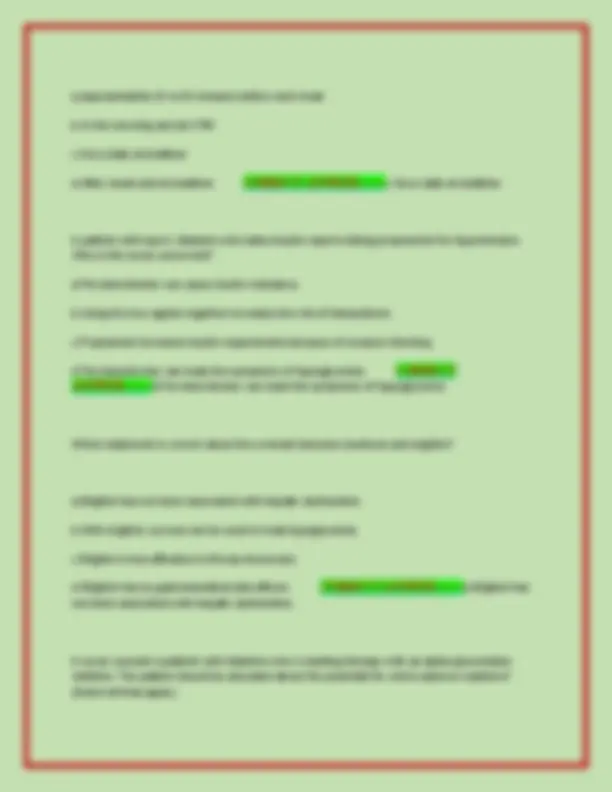

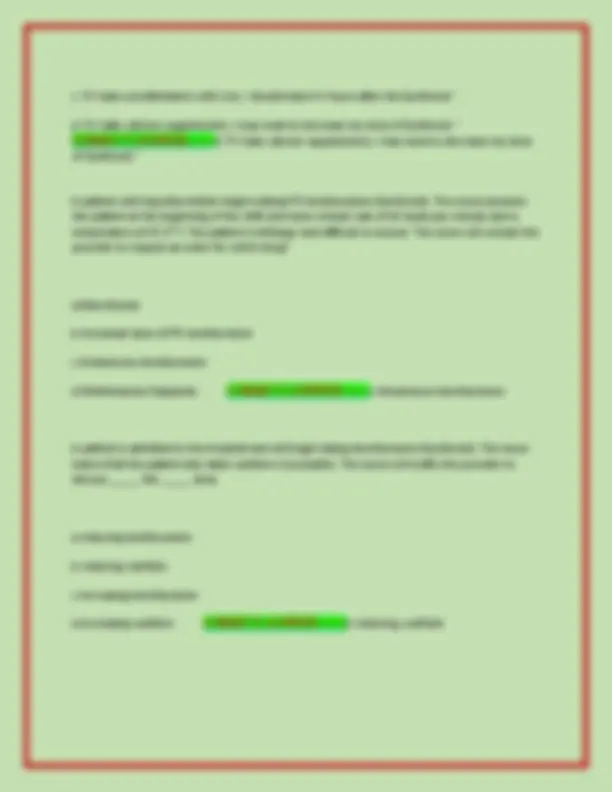
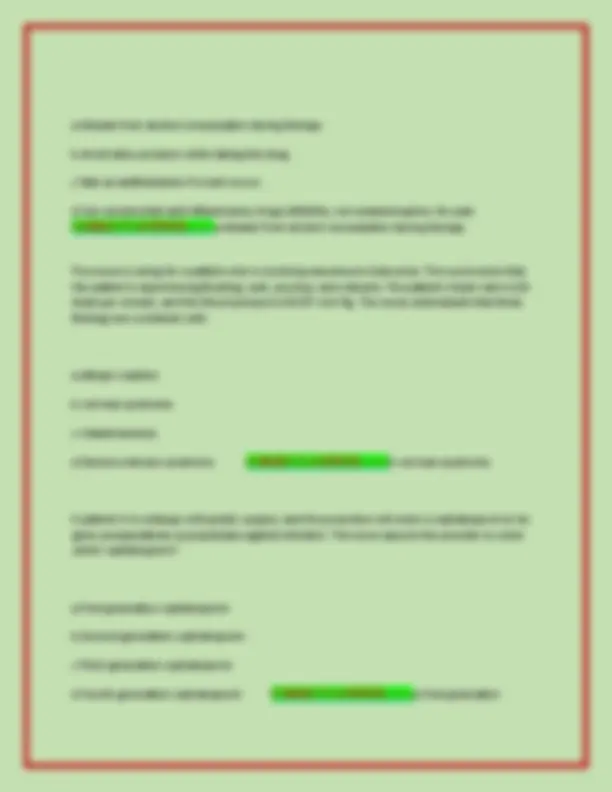
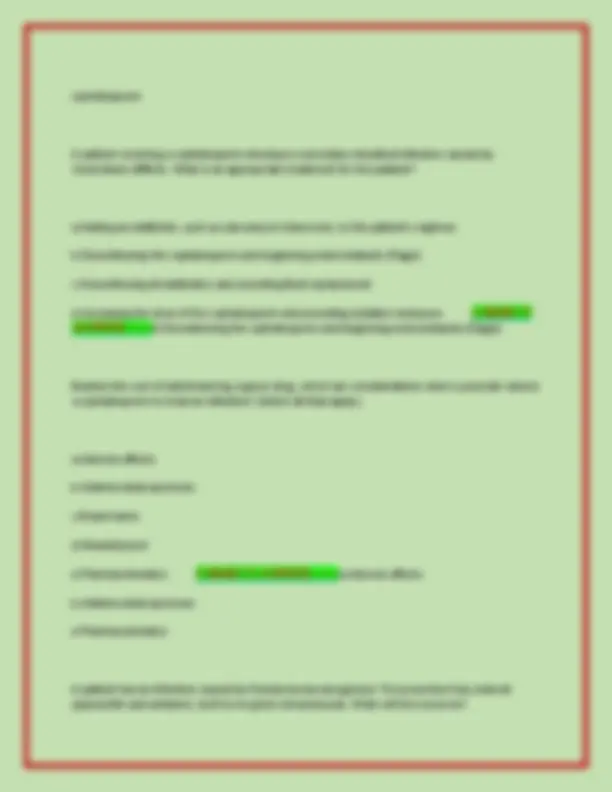
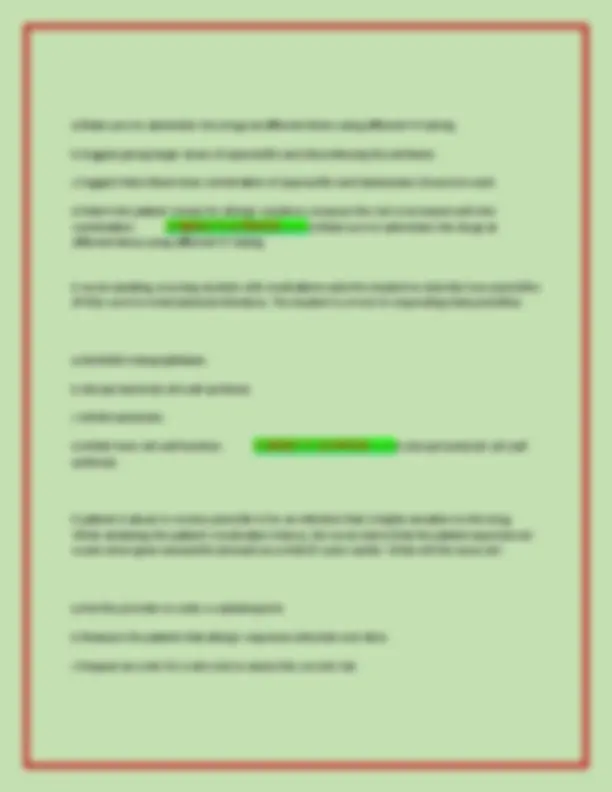
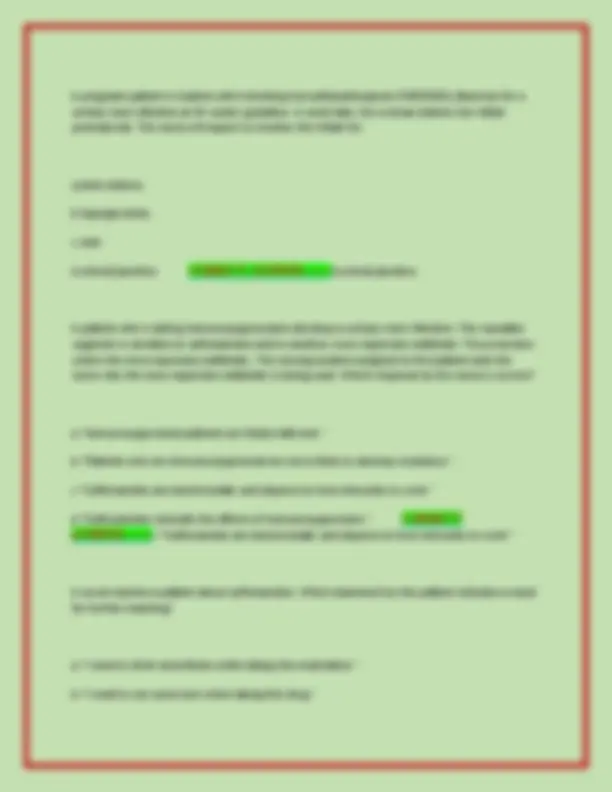
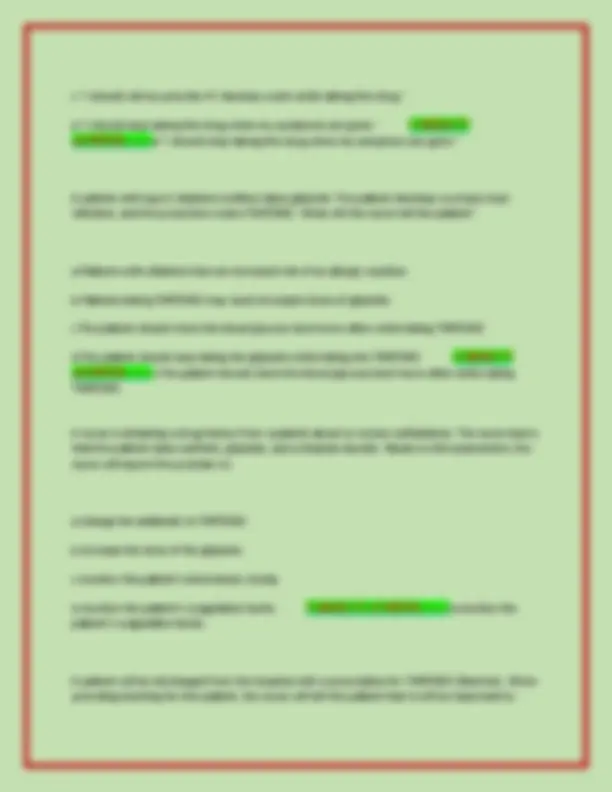
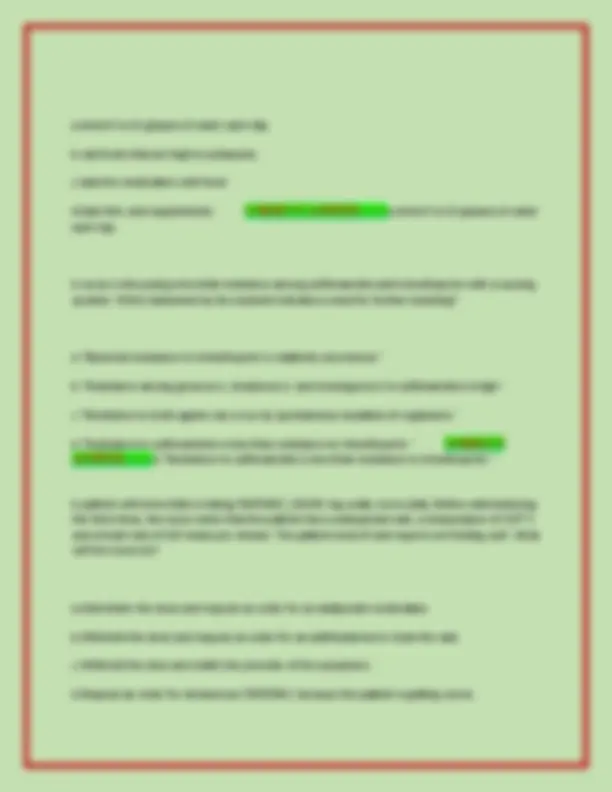
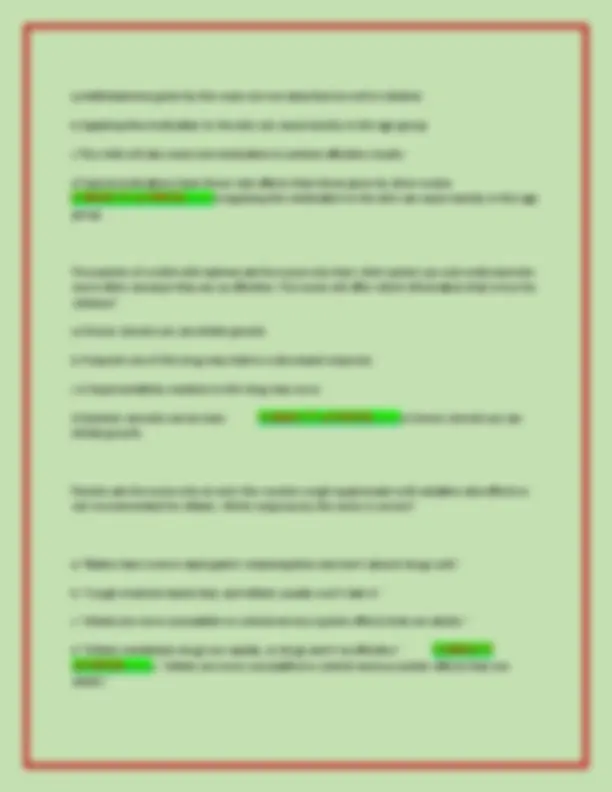
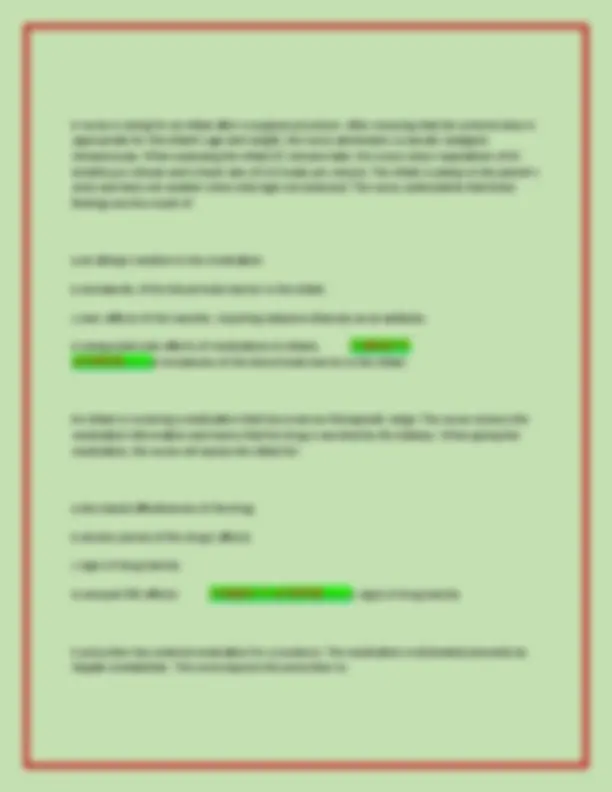
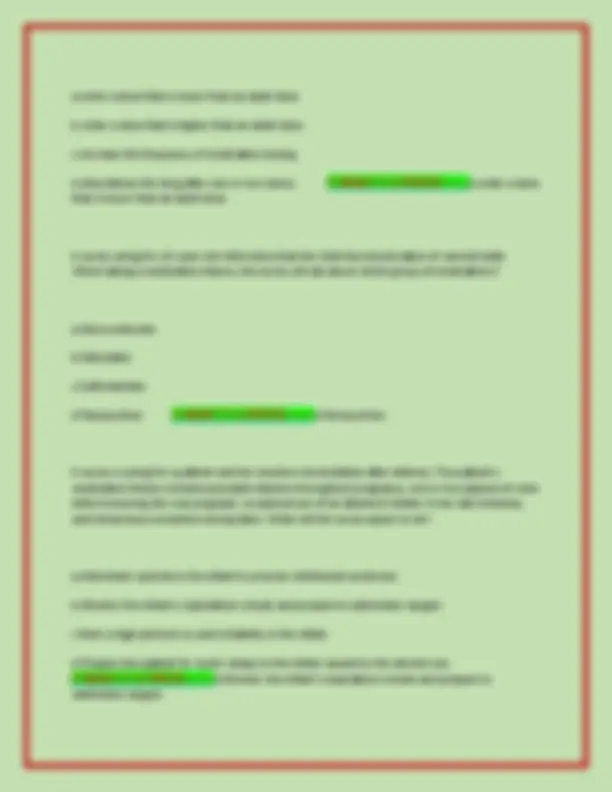
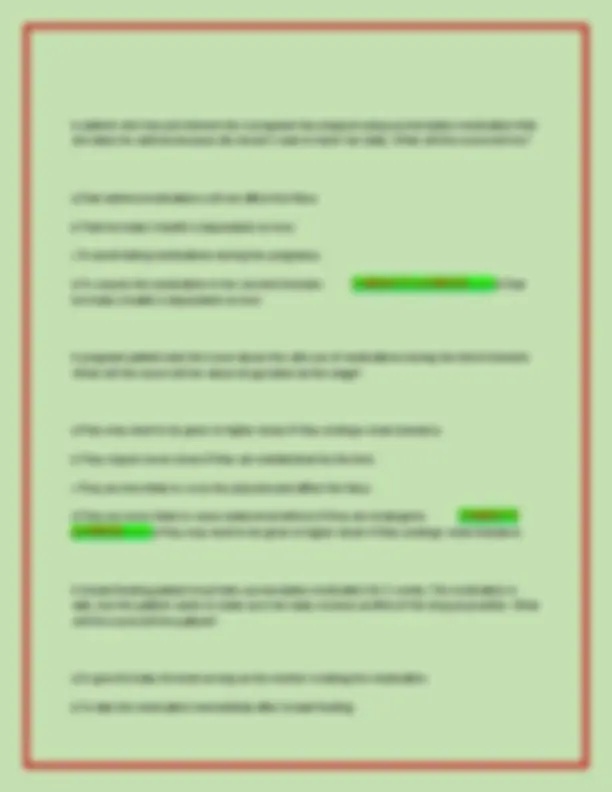
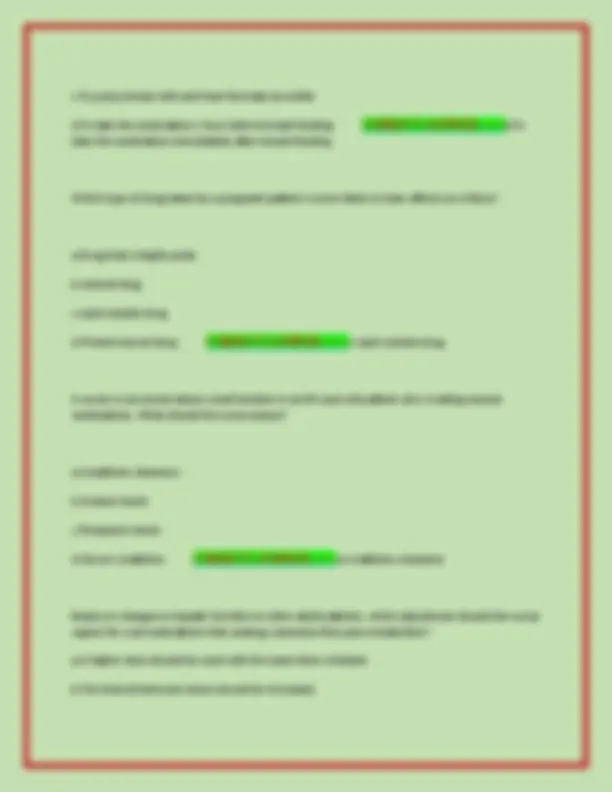
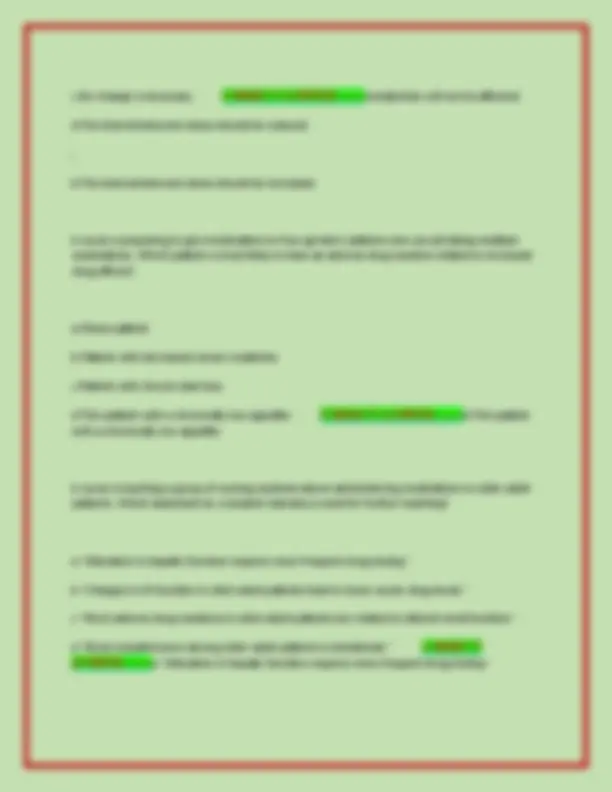
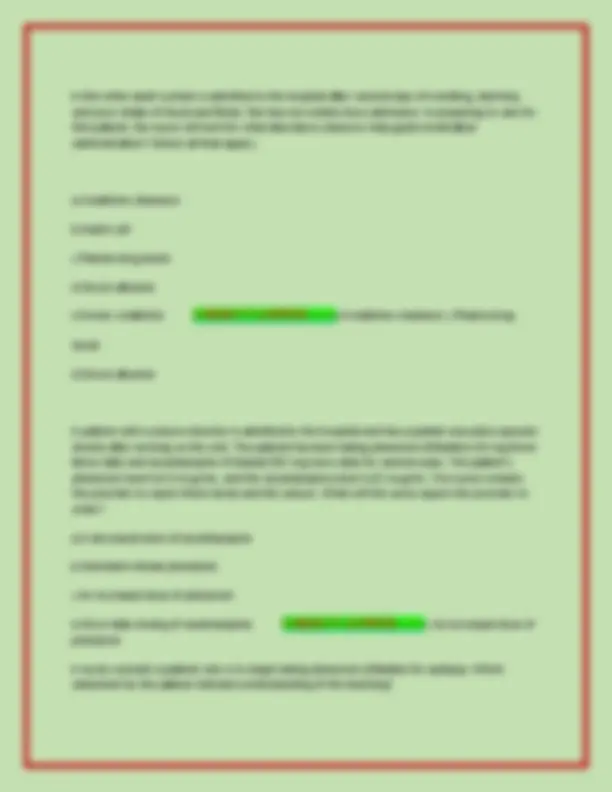
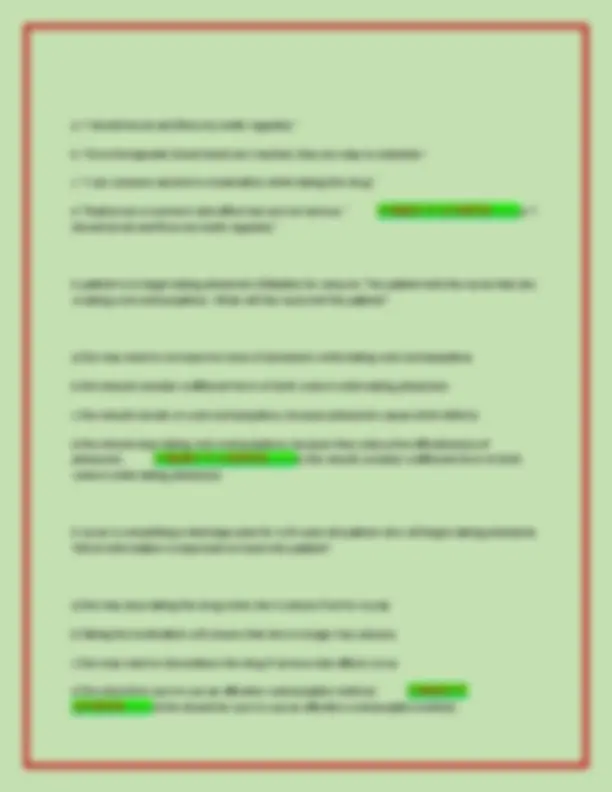
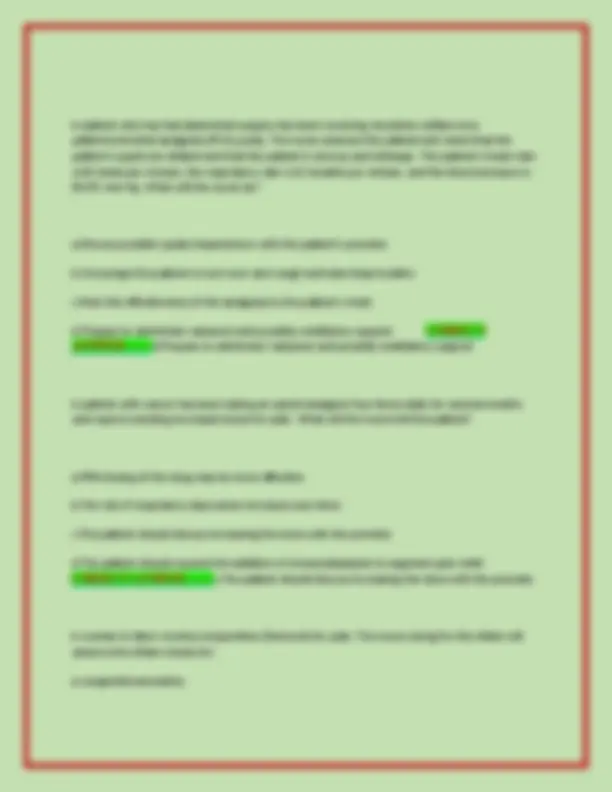
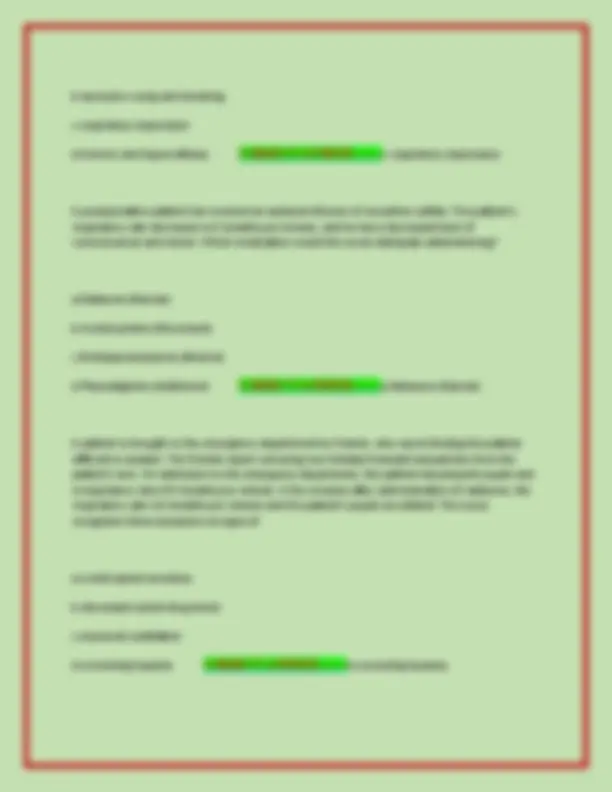
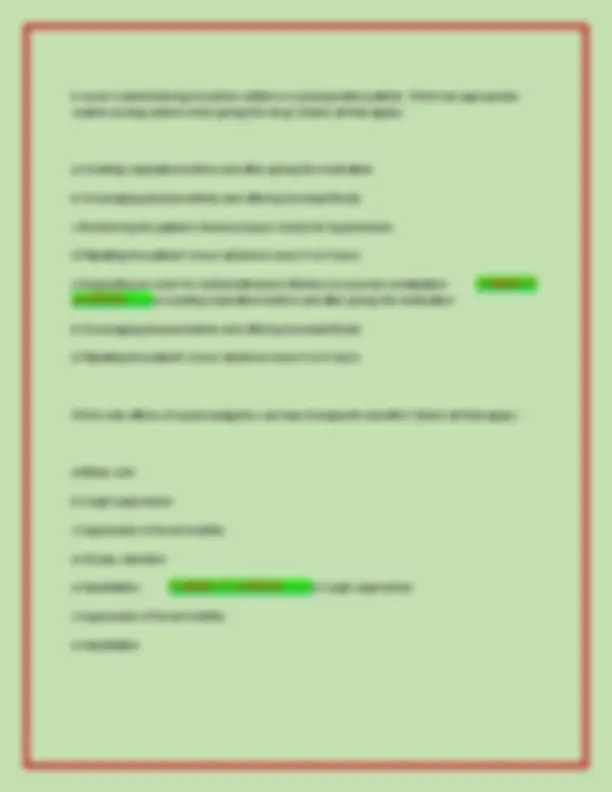
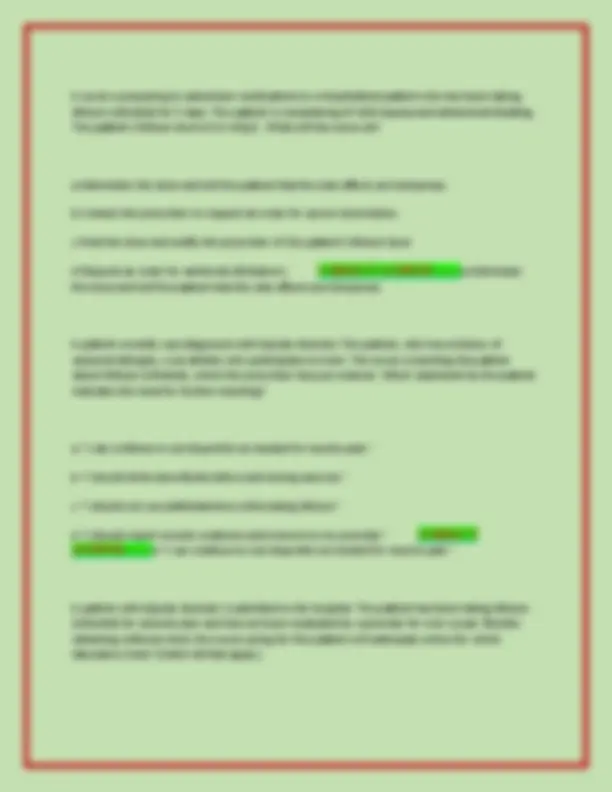
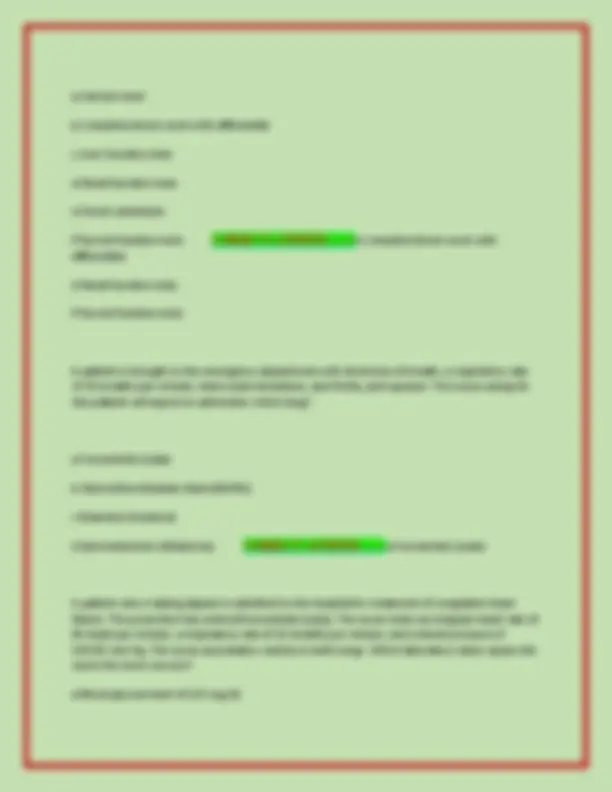
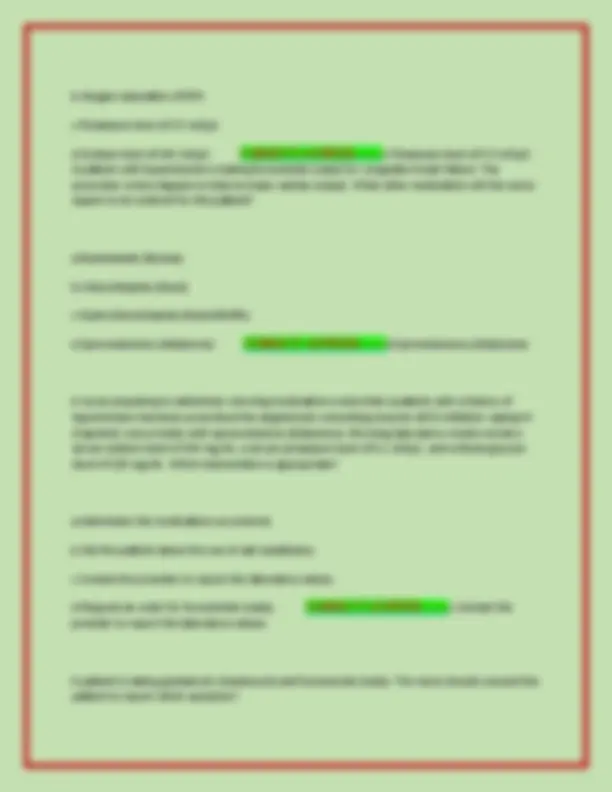
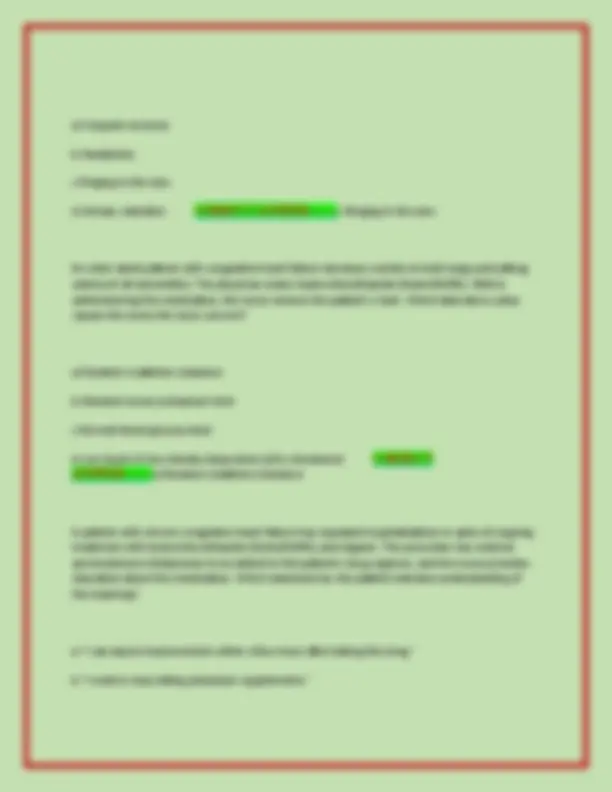
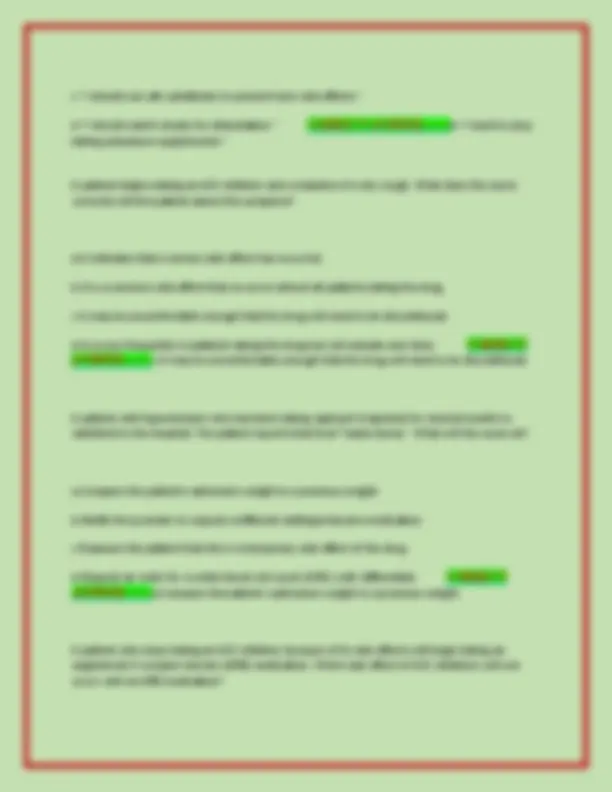
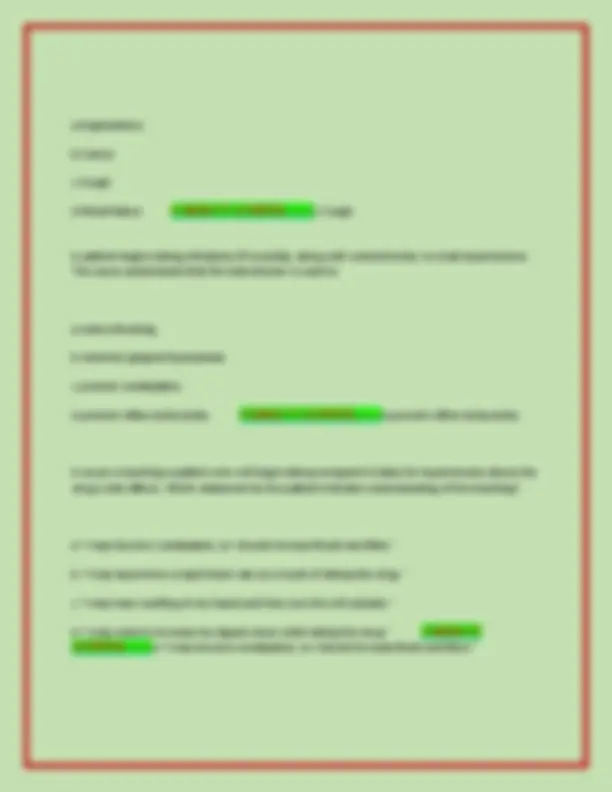
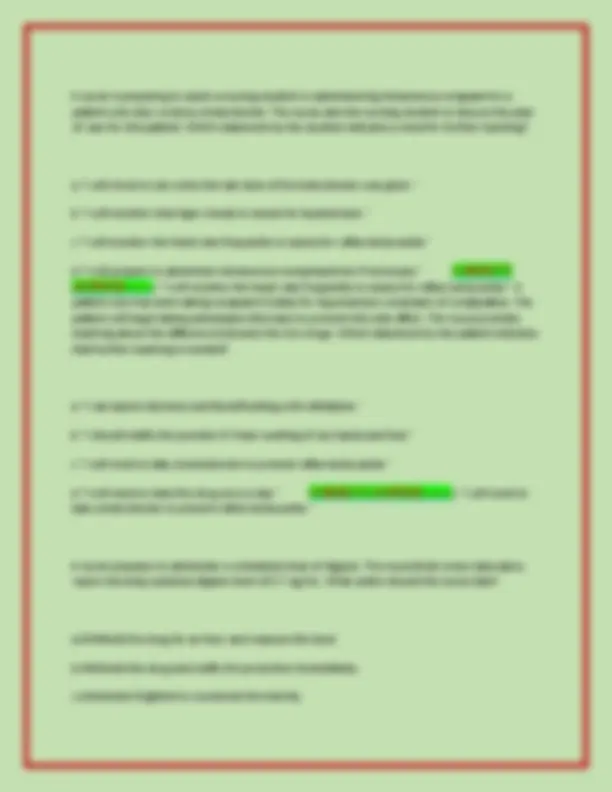
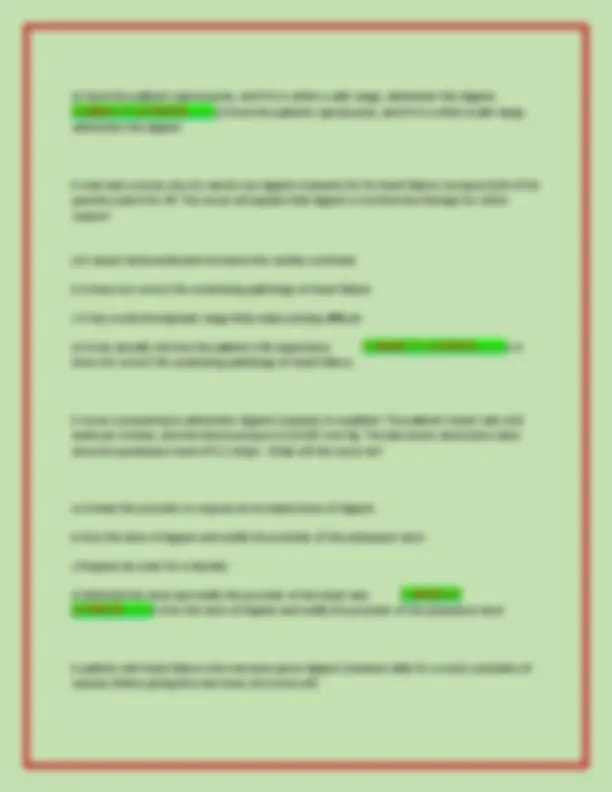
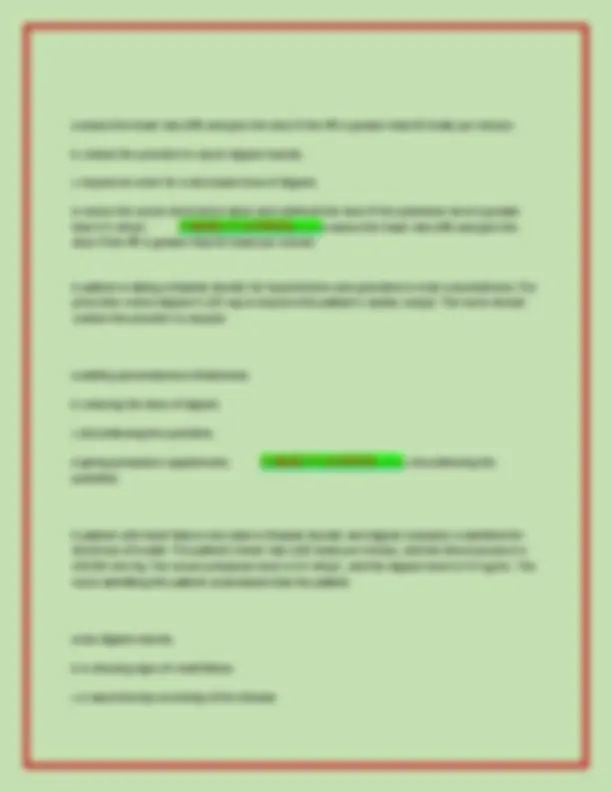
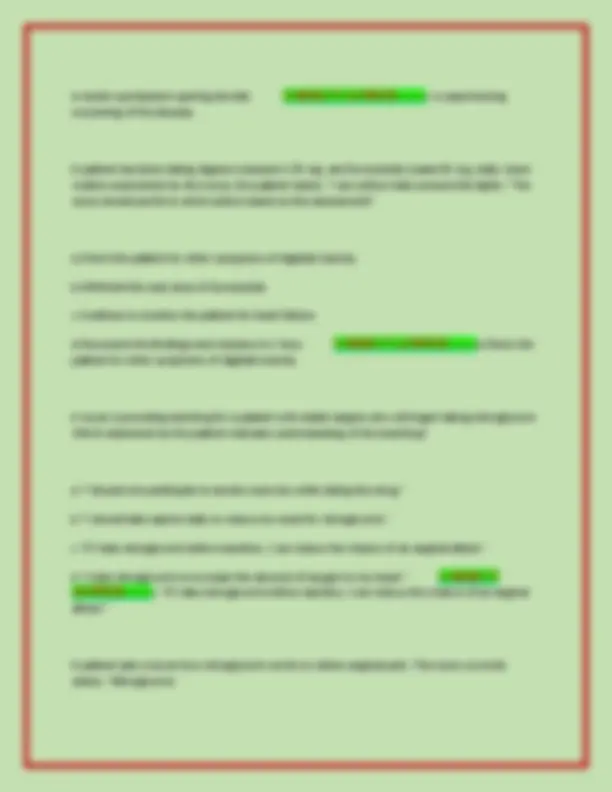
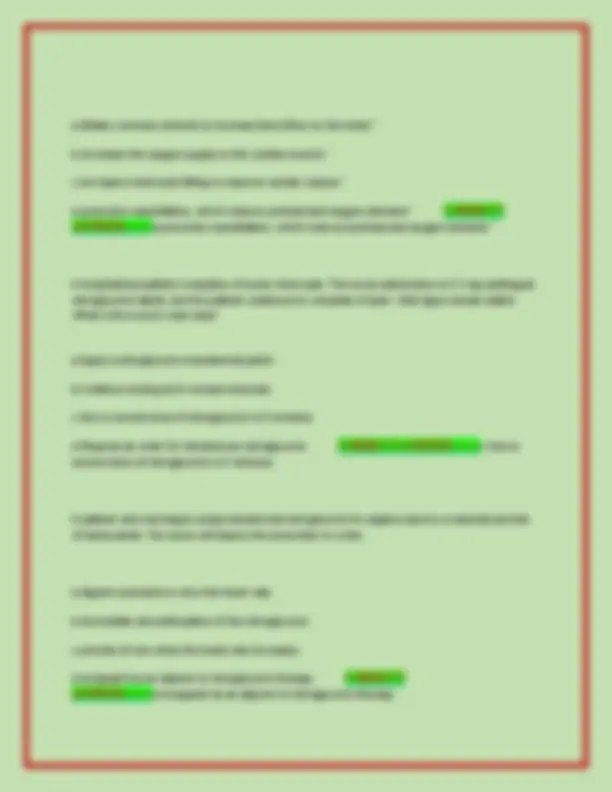
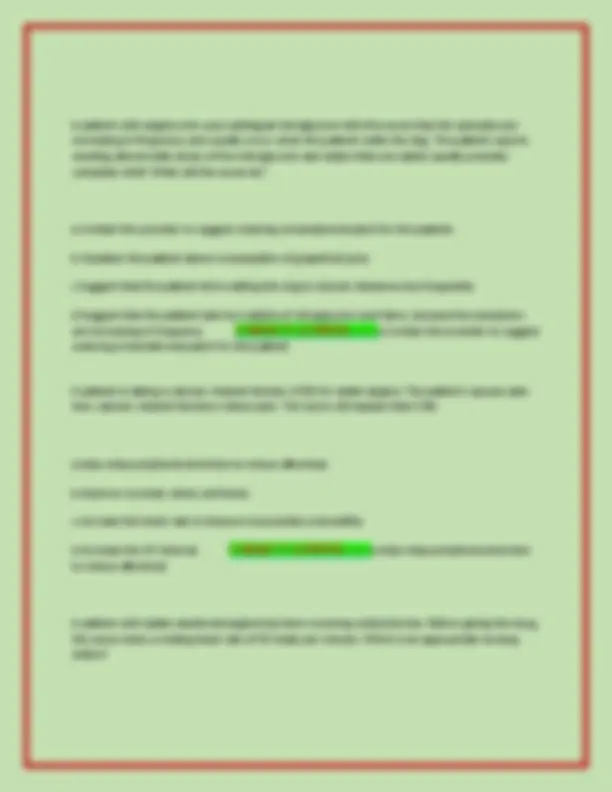
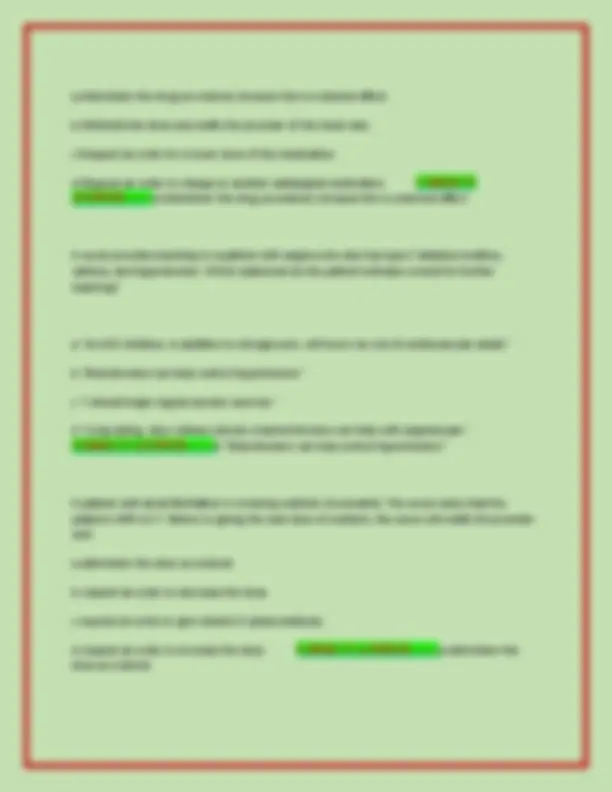
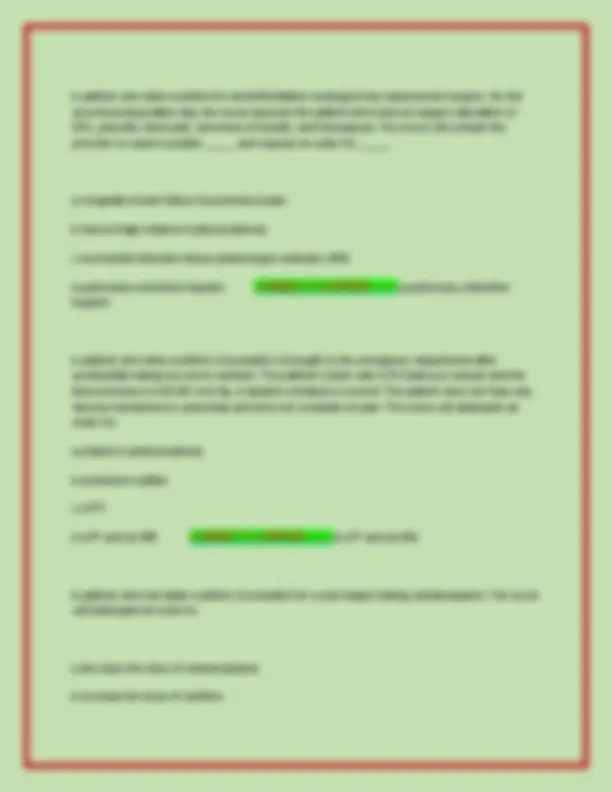
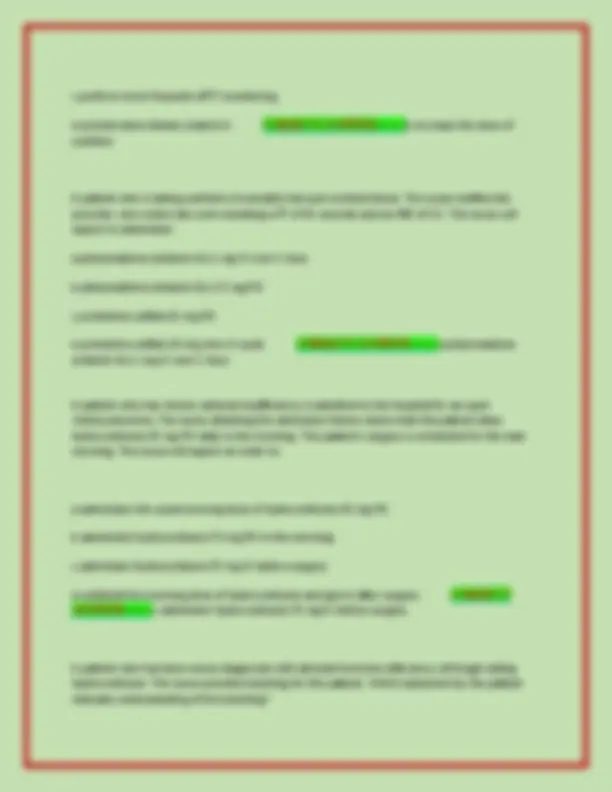
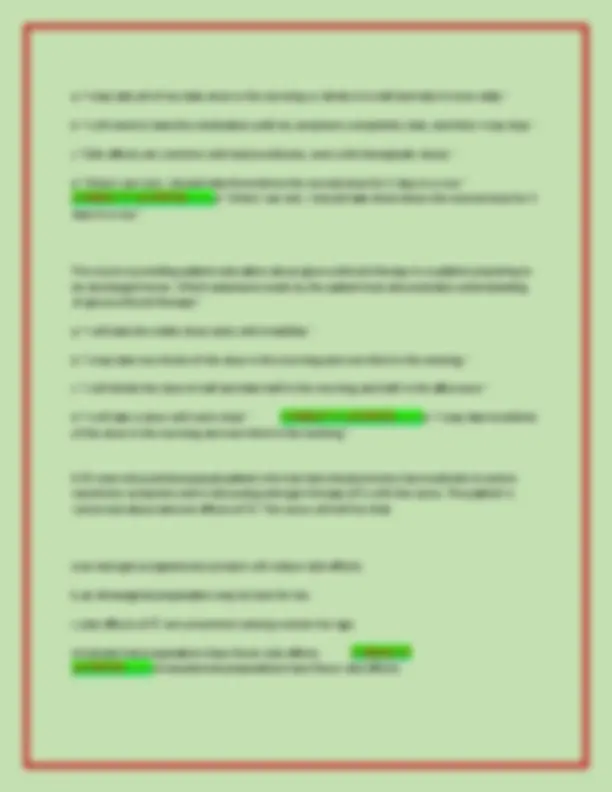
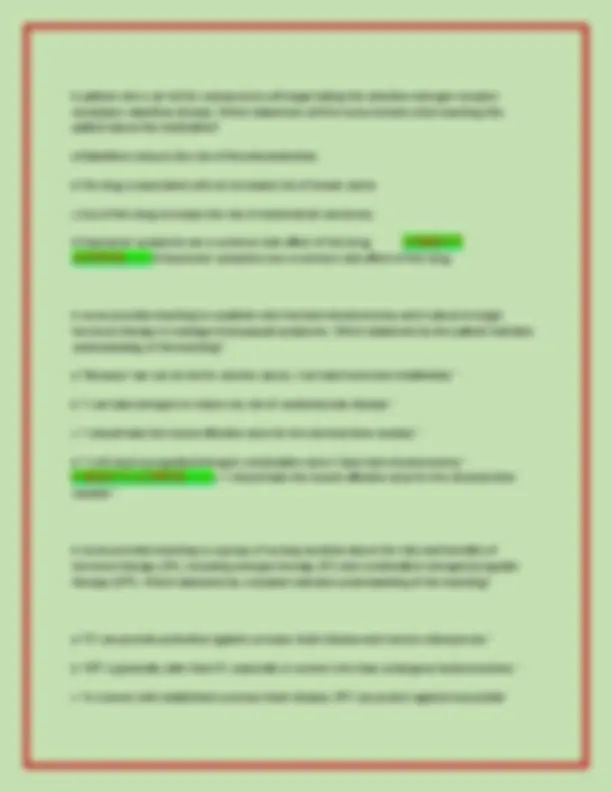
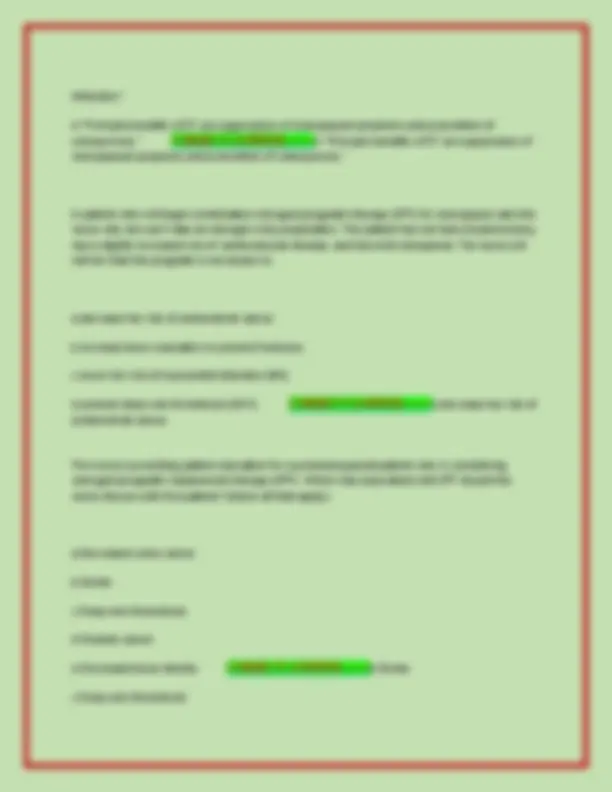
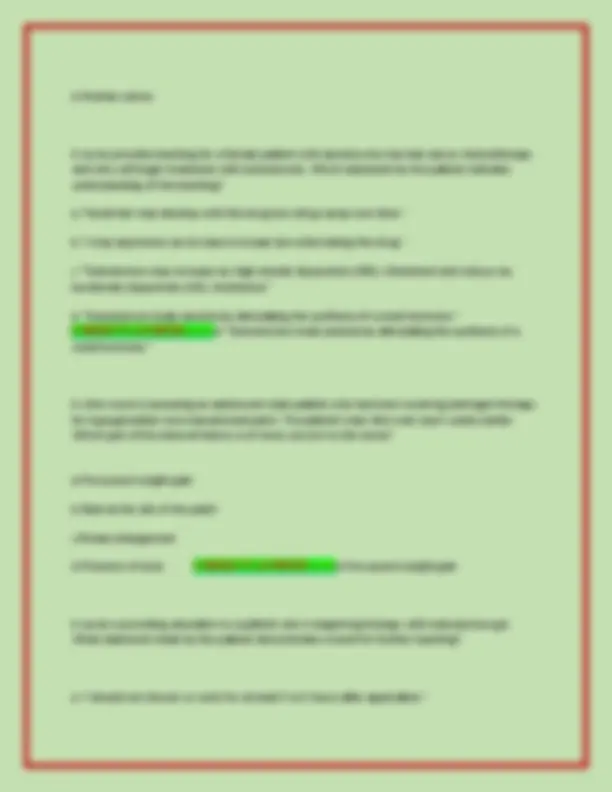
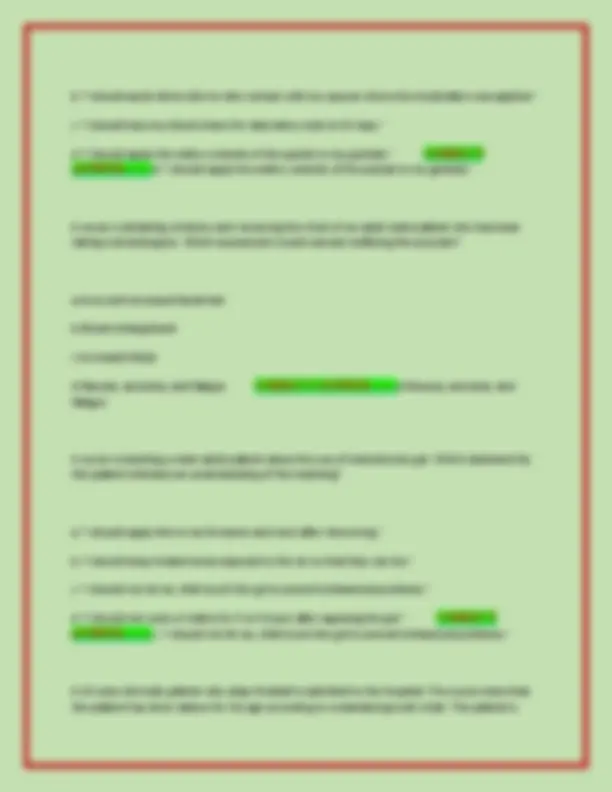
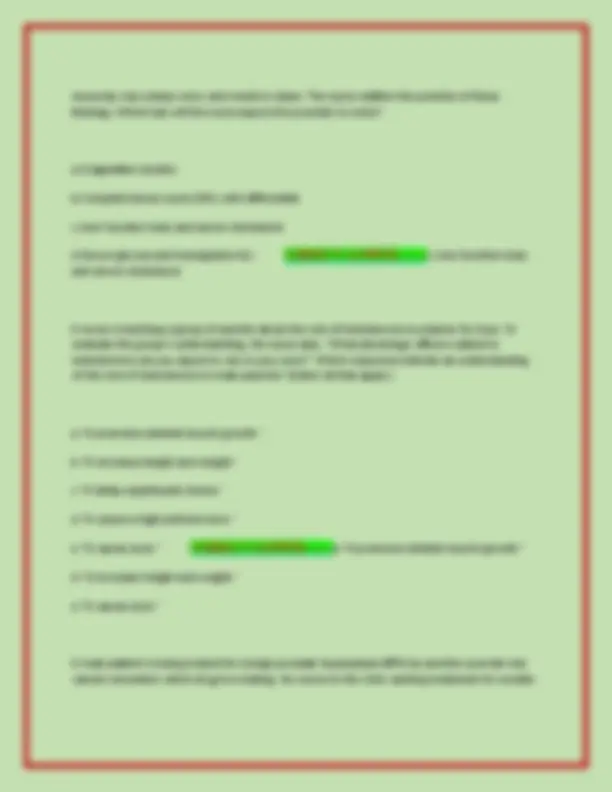
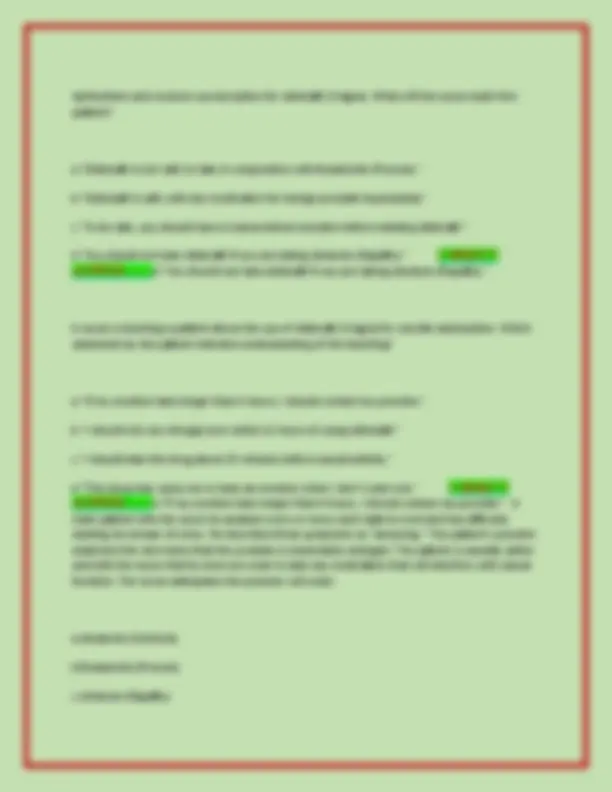
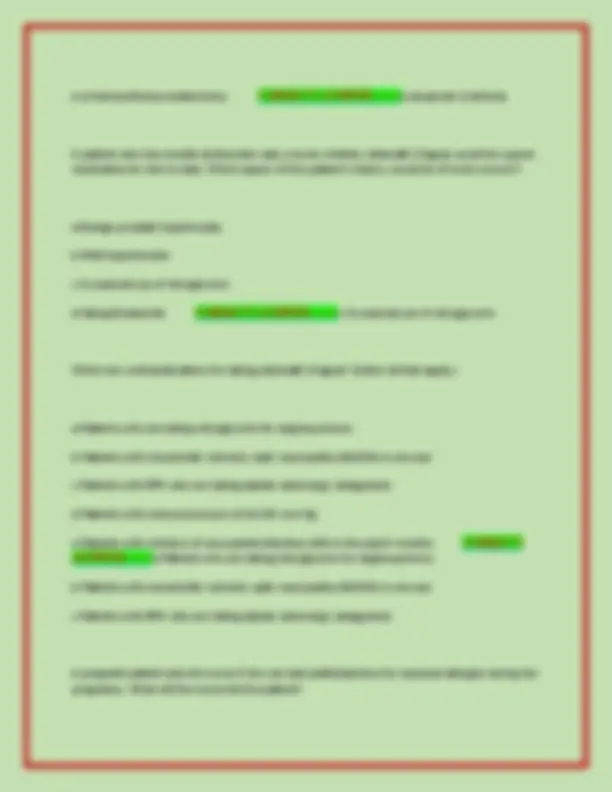
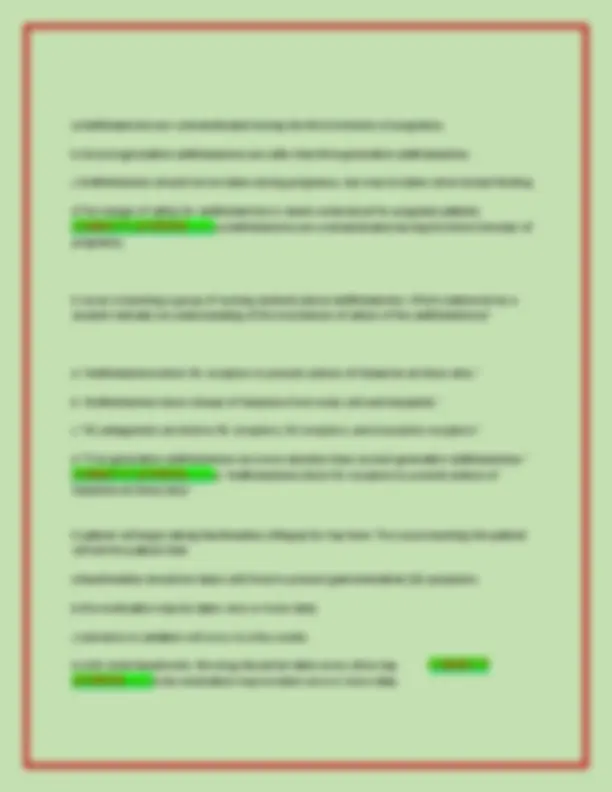
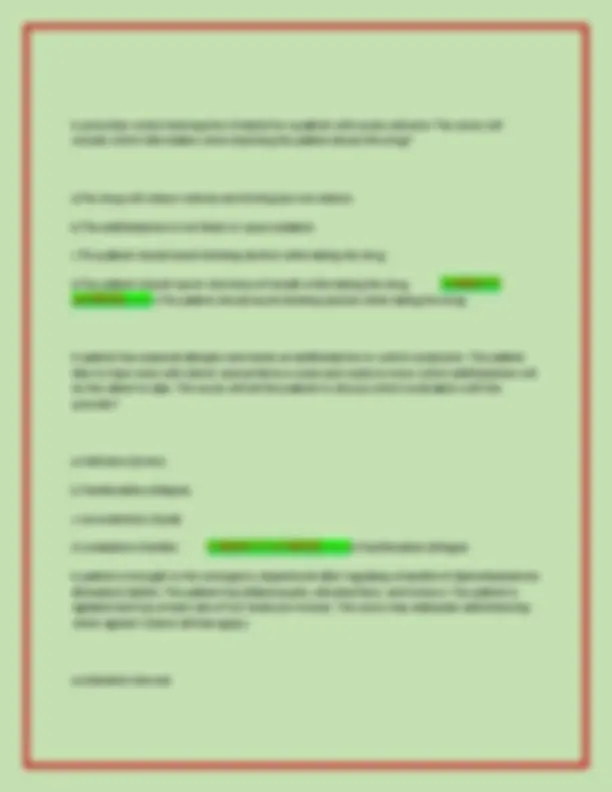
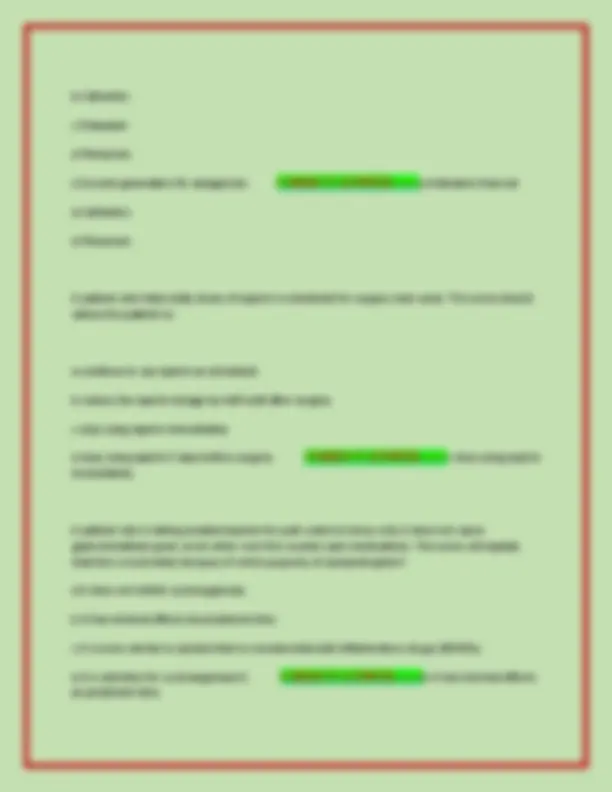
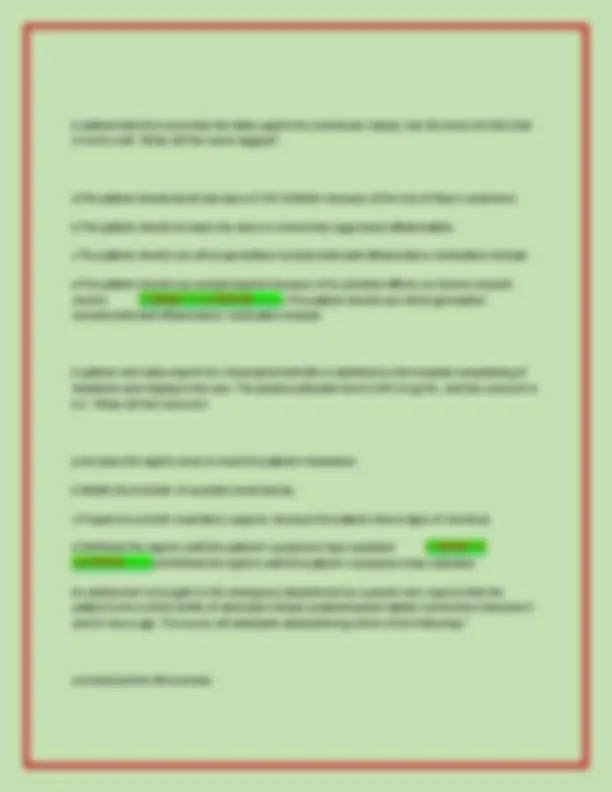
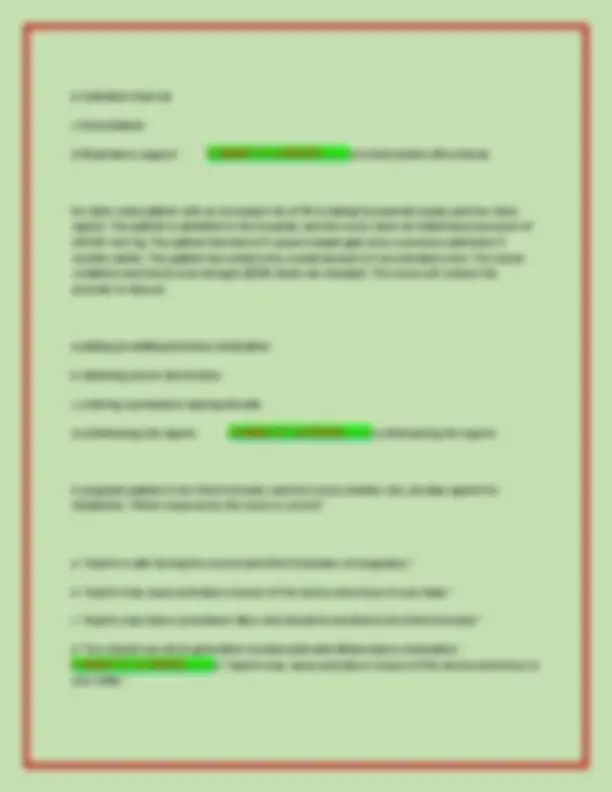

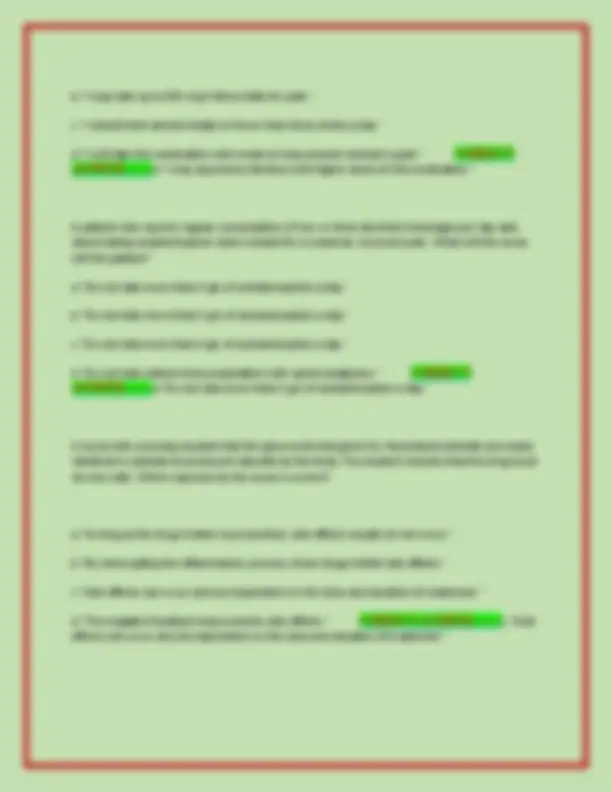
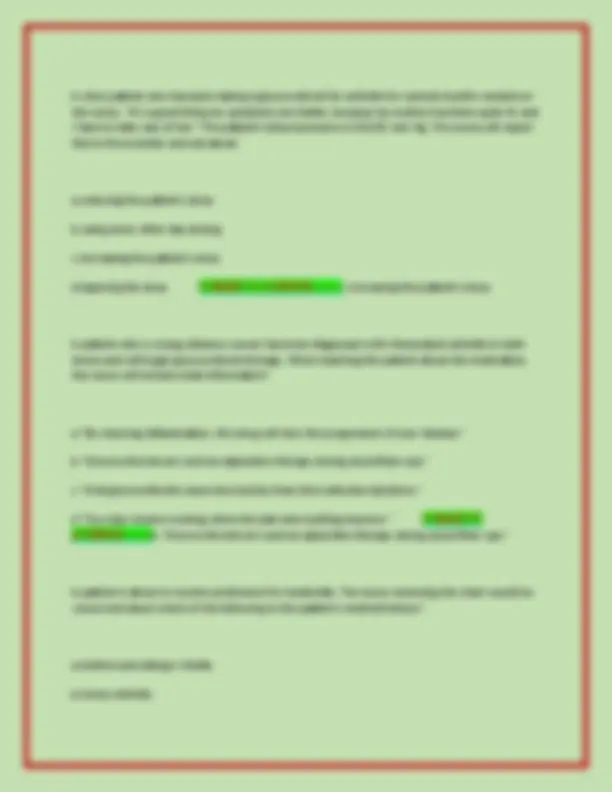
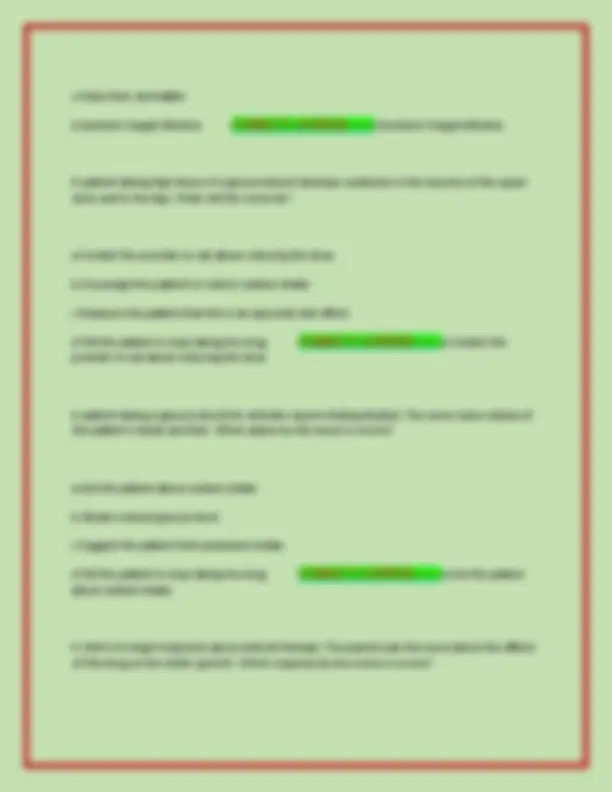
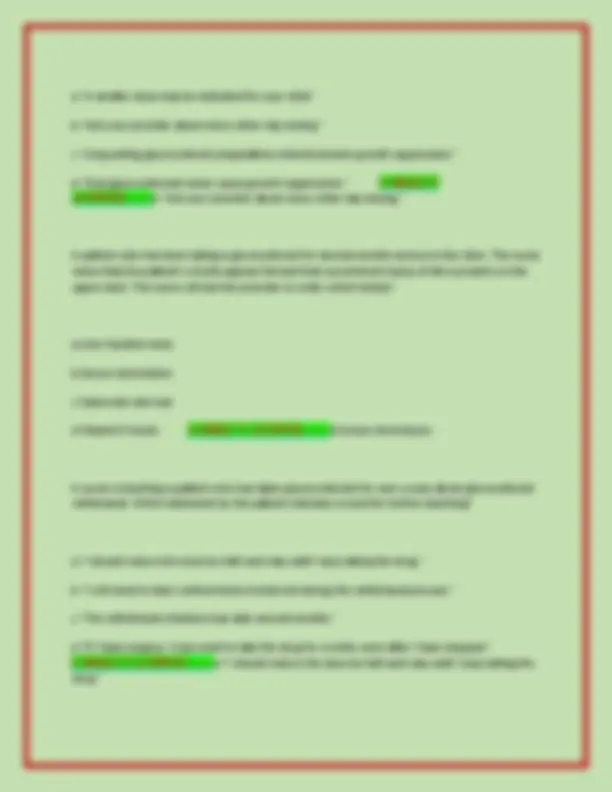
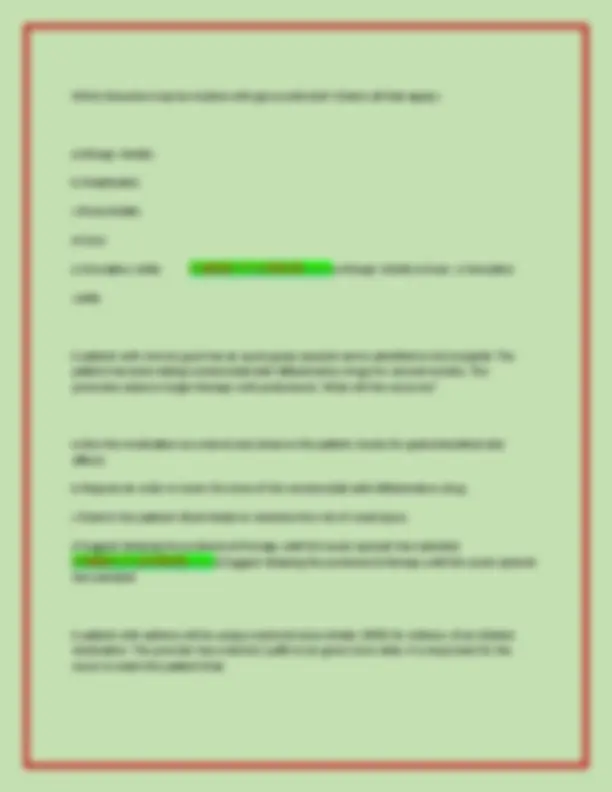
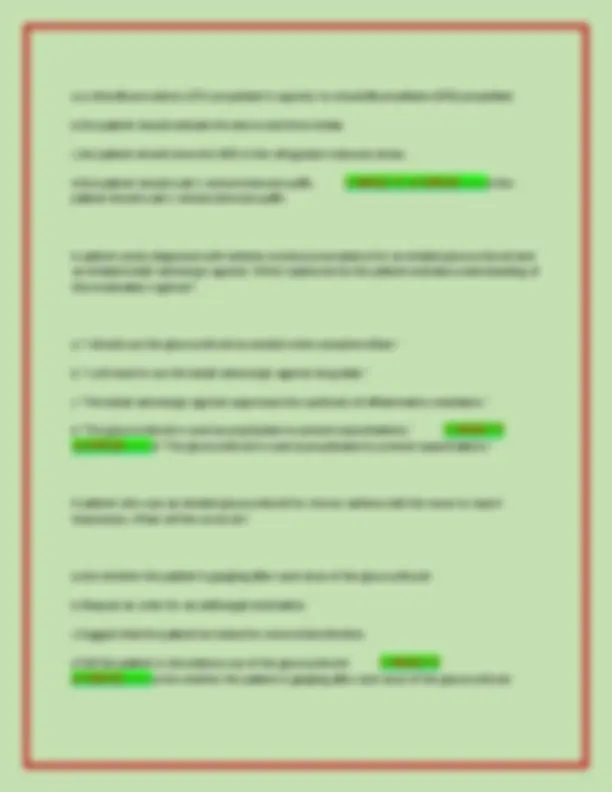
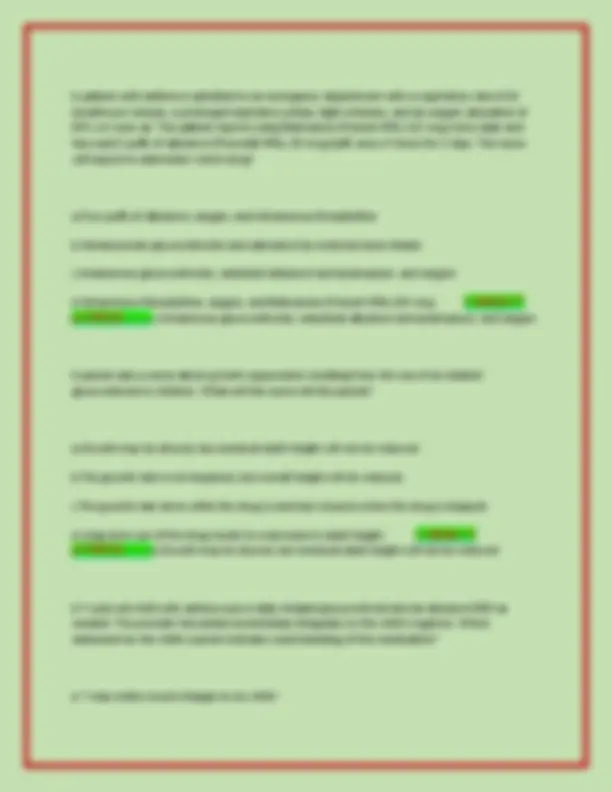
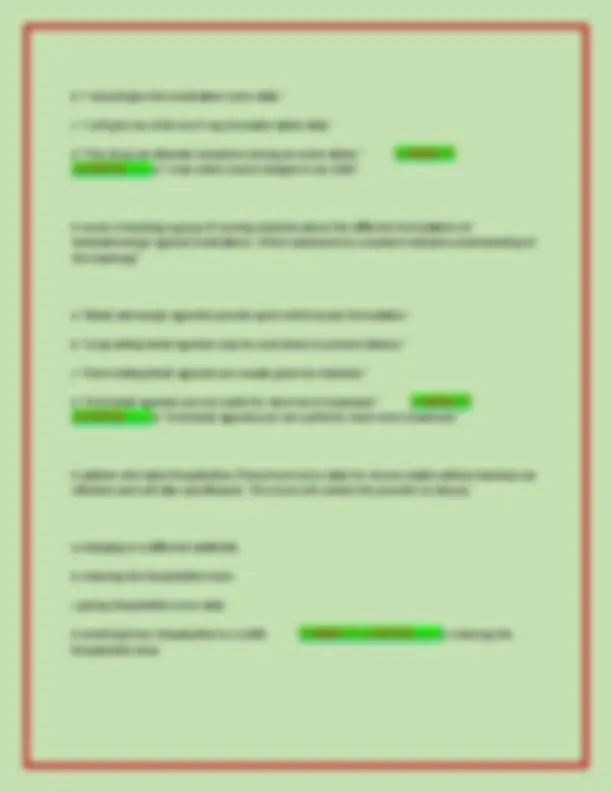
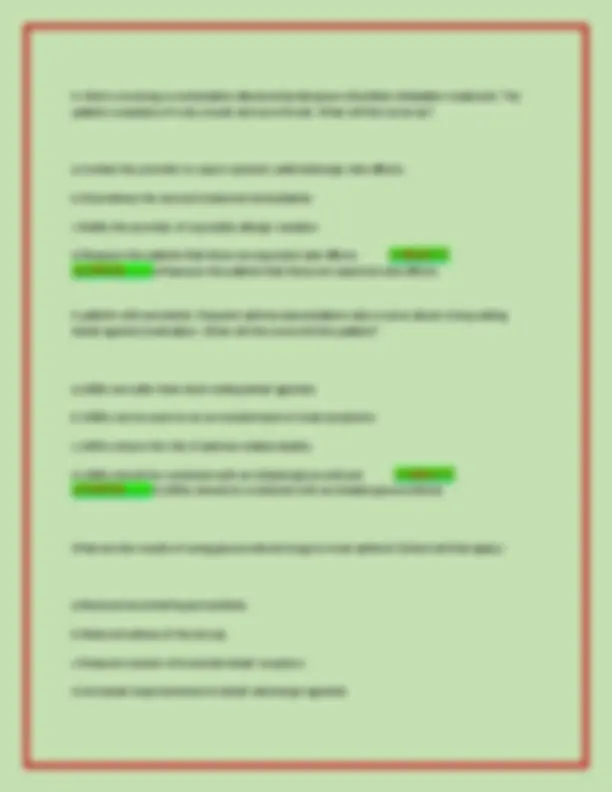
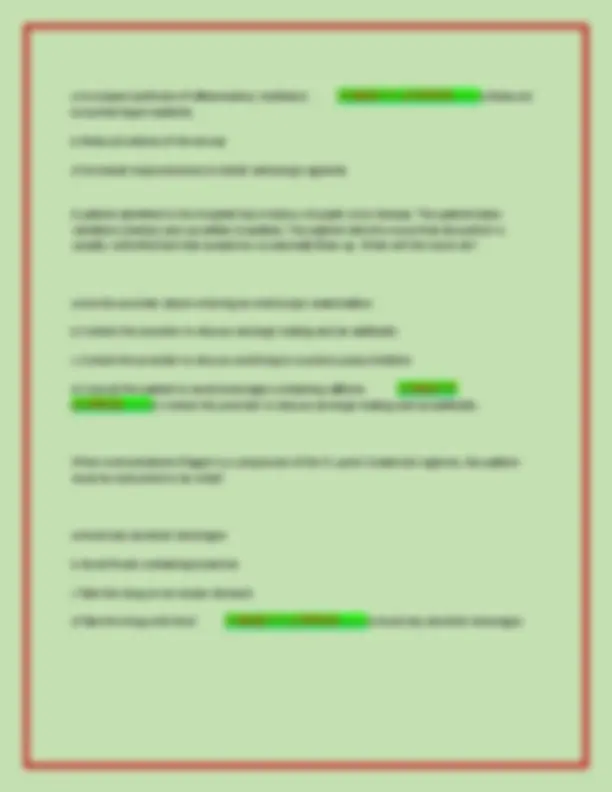
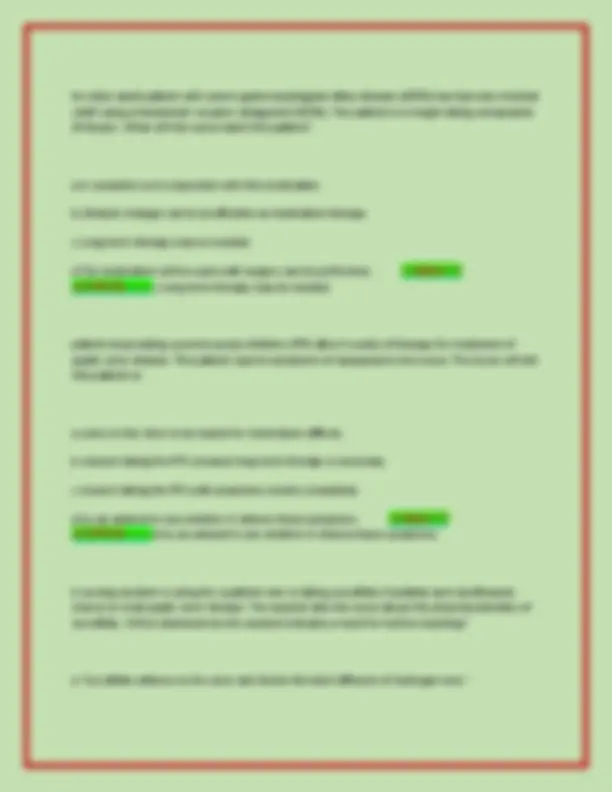
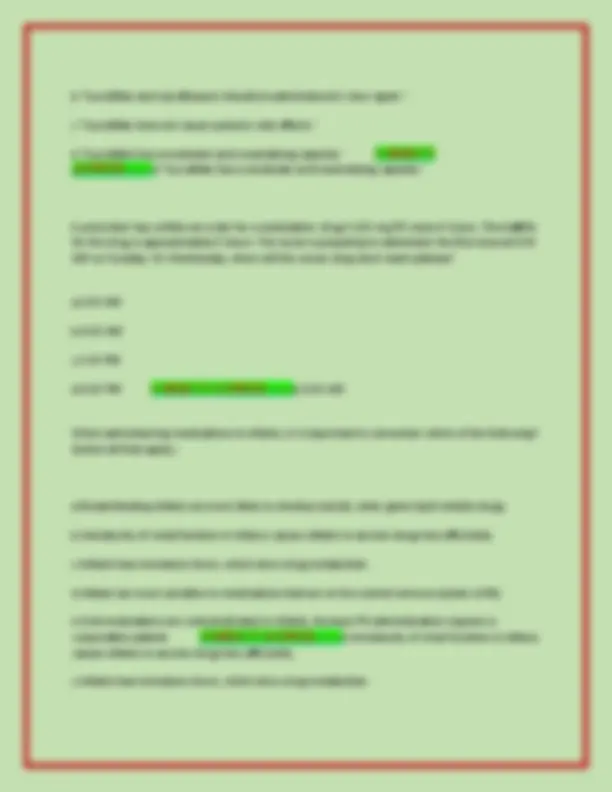
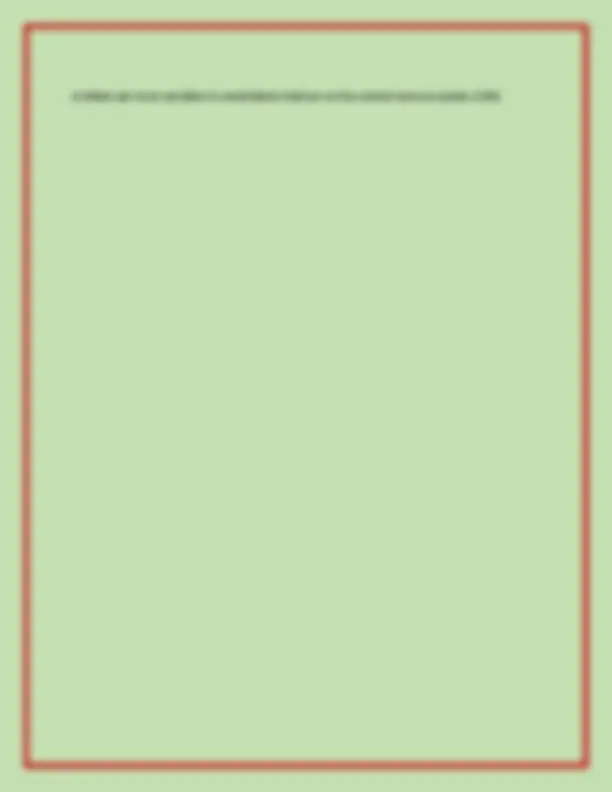


Study with the several resources on Docsity

Earn points by helping other students or get them with a premium plan


Prepare for your exams
Study with the several resources on Docsity

Earn points to download
Earn points by helping other students or get them with a premium plan
Community
Ask the community for help and clear up your study doubts
Discover the best universities in your country according to Docsity users
Free resources
Download our free guides on studying techniques, anxiety management strategies, and thesis advice from Docsity tutors
NUR 2474 PHARMACOLOGY MIDTERM 2024-2025 ACTUAL NEWEST EXAM QUESTIONS & ANSWERS UPDATED WITH A 100% GUARANTEED PASS The nurse working on a high-acuity medical-surgical unit is prioritizing care for four patients who were just admitted. Which patient should the nurse assess first? a.The NPO patient with a blood glucose level of 80 mg/dL who just received 20 units of 70/30 Novolin insulin b.The patient with a pulse of 58 beats per minute who is about to receive digoxin (Lanoxin) c.The patient with a blood pressure of 136/92 mm Hg who complains of having a headache d.The patient with an allergy to penicillin who is receiving an infusion of vancomycin (Vancocin) CORRECT ANSWER>>>>a.The NPO patient with a blood glucose level of 80 mg/dL who just received 20 units of 70/30 Novolin insulin
Typology: Exams
1 / 70

This page cannot be seen from the preview
Don't miss anything!































































The nurse working on a high-acuity medical-surgical unit is prioritizing care for four patients who were just admitted. Which patient should the nurse assess first? a.The NPO patient with a blood glucose level of 80 mg/dL who just received 20 units of 70/ Novolin insulin b.The patient with a pulse of 58 beats per minute who is about to receive digoxin (Lanoxin) c.The patient with a blood pressure of 136/92 mm Hg who complains of having a headache d.The patient with an allergy to penicillin who is receiving an infusion of vancomycin (Vancocin) CORRECT ANSWER>>>> a.The NPO patient with a blood glucose level of 80 mg/dL who just received 20 units of 70/30 Novolin insulin A patient with type 1 diabetes is eating breakfast at 7:30 AM. Blood sugars are on a sliding scale and are ordered before a meal and at bedtime. The patient's blood sugar level is 317 mg/dL. Which formulation of insulin should the nurse prepare to administer? a.No insulin should be administered. b.NPH c.70/30 mix d.Lispro (Humalog) CORRECT ANSWER>>>> d.Lispro (Humalog)
A patient with type 1 diabetes recently became pregnant. The nurse plans a blood glucose testing schedule for her. What is the recommended monitoring schedule? a.Before each meal and before bed b.In the morning for a fasting level and at 4 PM for the peak level c.Six or seven times a day d.Three times a day, along with urine glucose testing CORRECT ANSWER>>>> c.Six or seven times a day An adolescent patient recently attended a health fair and had a serum glucose test. The patient telephones the nurse and says, "My level was 125 mg/dL. Does that mean I have diabetes?" What is the nurse's most accurate response? a."Unless you were fasting for longer than 8 hours, this does not necessarily mean you have diabetes." b."At this level, you probably have diabetes. You will need an oral glucose tolerance test this week." c."This level is conclusive evidence that you have diabetes." d."This level is conclusive evidence that you do not have diabetes." CORRECT ANSWER>>>> a."Unless you were fasting for longer than 8 hours, this does not necessarily mean you have diabetes." Insulin glargine is prescribed for a hospitalized patient who is diabetic. When will the nurse administer this drug?
a.Hypoglycemia b.Flatulence c.Elevated iron levels in the blood d.Fluid retention e.Diarrhea CORRECT ANSWER>>>> b.Flatulence e.Diarrhea The nurse is caring for a pregnant patient recently diagnosed with hypothyroidism. The patient tells the nurse she does not want to take medications while she is pregnant. What will the nurse explain to this patient? a.Hypothyroidism is a normal effect of pregnancy and usually is of no consequence. b.Neuropsychologic deficits in the fetus can occur if the condition is not treated. c.No danger to the fetus exists until the third trimester. d.Treatment is required only if the patient is experiencing symptoms. CORRECT ANSWER>>>> b.Neuropsychologic deficits in the fetus can occur if the condition is not treated. A nurse is teaching a patient who has been diagnosed with hypothyroidism about levothyroxine (Synthroid). Which statement by the patient indicates a need for further teaching? a."I should not take heartburn medication without consulting my provider." b."I should report insomnia, tremors, and an increased heart rate to my provider."
c."If I take a multivitamin with iron, I should take it 4 hours after the Synthroid." d."If I take calcium supplements, I may need to decrease my dose of Synthroid." CORRECT ANSWER>>>> d."If I take calcium supplements, I may need to decrease my dose of Synthroid." A patient with hypothyroidism begins taking PO levothyroxine (Synthroid). The nurse assesses the patient at the beginning of the shift and notes a heart rate of 62 beats per minute and a temperature of 97.2° F. The patient is lethargic and difficult to arouse. The nurse will contact the provider to request an order for which drug? a.Beta blocker b.Increased dose of PO levothyroxine c.Intravenous levothyroxine d.Methimazole (Tapazole) CORRECT ANSWER>>>> c.Intravenous levothyroxine A patient is admitted to the hospital and will begin taking levothyroxine (Synthroid). The nurse learns that the patient also takes warfarin (Coumadin). The nurse will notify the provider to discuss _____ the _____ dose. a.reducing levothyroxine b.reducing warfarin c.increasing levothyroxine d.increasing warfarin CORRECT ANSWER>>>> b.reducing; warfarin
c.Select an alternate intravenous site and administer the infusion more slowly. d.Request central venous access. CORRECT ANSWER>>>> c.Select an alternate intravenous site and administer the infusion more slowly. A nurse is teaching a nursing student what is meant by "generations" of cephalosporins. Which statement by the student indicates understanding of the teaching? a."Cephalosporins are assigned to generations based on their relative costs to administer." b."Cephalosporins have increased activity against gram-negative bacteria with each generation." c."First-generation cephalosporins have better penetration of the cerebrospinal fluid." d."Later generations of cephalosporins have lower resistance to destruction by betalactamases." CORRECT ANSWER>>>> b."Cephalosporins have increased activity against gram-negative bacteria with each generation." A provider has ordered ceftriaxone 4 gm once daily for a patient with renal impairment. What will the nurse do? a.Administer the medication as prescribed. b.Contact the provider to ask about giving the drug in divided doses. c.Discuss increasing the interval between doses with the provider. d.Discuss reducing the dose with the provider. CORRECT ANSWER>>>> a.Administer the medication as prescribed. A patient will be discharged home to complete treatment with intravenous cefotetan with the assistance of a home nurse. The home care nurse will include which instruction when teaching the patient about this drug treatment?
a.Abstain from alcohol consumption during therapy. b.Avoid dairy products while taking this drug. c.Take an antihistamine if a rash occurs. d.Use nonsteroidal anti-inflammatory drugs (NSAIDs), not acetaminophen, for pain. CORRECT ANSWER>>>> a.Abstain from alcohol consumption during therapy. The nurse is caring for a patient who is receiving vancomycin (Vancocin). The nurse notes that the patient is experiencing flushing, rash, pruritus, and urticaria. The patient's heart rate is 120 beats per minute, and the blood pressure is 92/57 mm Hg. The nurse understands that these findings are consistent with: a.allergic reaction. b.red man syndrome. c.rhabdomyolysis. d.Stevens-Johnson syndrome. CORRECT ANSWER>>>> b.red man syndrome. A patient is to undergo orthopedic surgery, and the prescriber will order a cephalosporin to be given preoperatively as prophylaxis against infection. The nurse expects the provider to order which cephalosporin? a.First-generation cephalosporin b.Second-generation cephalosporin c.Third-generation cephalosporin d.Fourth-generation cephalosporin CORRECT ANSWER>>>> a.First-generation
a.Make sure to administer the drugs at different times using different IV tubing. b.Suggest giving larger doses of piperacillin and discontinuing the amikacin. c.Suggest that a fixed-dose combination of piperacillin and tazobactam (Zosyn) be used. d.Watch the patient closely for allergic reactions, because this risk is increased with this combination. CORRECT ANSWER>>>> a.Make sure to administer the drugs at different times using different IV tubing. A nurse assisting a nursing student with medications asks the student to describe how penicillins (PCNs) work to treat bacterial infections. The student is correct in responding that penicillins: a.disinhibit transpeptidases. b.disrupt bacterial cell wall synthesis. c.inhibit autolysins. d.inhibit host cell wall function. CORRECT ANSWER>>>> b.disrupt bacterial cell wall synthesis. A patient is about to receive penicillin G for an infection that is highly sensitive to this drug. While obtaining the patient's medication history, the nurse learns that the patient experienced a rash when given amoxicillin (Amoxil) as a child 20 years earlier. What will the nurse do? a.Ask the provider to order a cephalosporin. b.Reassure the patient that allergic responses diminish over time. c.Request an order for a skin test to assess the current risk.
d.Suggest using a desensitization schedule to administer the drug. CORRECT ANSWER>>>> c.Request an order for a skin test to assess the current risk. A patient with no known drug allergies is receiving amoxicillin (Amoxil) PO twice daily. Twenty minutes after being given a dose, the patient complains of shortness of breath. The patient's blood pressure is 100/58 mm Hg. What will the nurse do? a.Contact the provider and prepare to administer epinephrine. b.Notify the provider if the patient develops a rash. c.Request an order for a skin test to evaluate possible PCN allergy. d.Withhold the next dose until symptoms subside. CORRECT ANSWER>>>> a.Contact the provider and prepare to administer epinephrine. A patient with an infection caused by Pseudomonas aeruginosa is being treated with piperacillin. The nurse providing care reviews the patient's laboratory reports and notes that the patient's blood urea nitrogen and serum creatinine levels are elevated. The nurse will contact the provider to discuss: a.adding an aminoglycoside. b.changing to penicillin G. c.reducing the dose of piperacillin. d.ordering nafcillin. CORRECT ANSWER>>>> c.reducing the dose of piperacillin. A patient recently began receiving clindamycin (Cleocin) to treat an infection. After 8 days of treatment, the patient reports having 10 to 15 watery stools per day. What will the nurse tell this patient?
A pregnant patient is treated with trimethoprim/sulfamethoxazole (TMP/SMZ) (Bactrim) for a urinary tract infection at 34 weeks' gestation. A week later, the woman delivers her infant prematurely. The nurse will expect to monitor the infant for: a.birth defects. b.hypoglycemia. c.rash. d.scleral jaundice. CORRECT ANSWER>>>> d.scleral jaundice. A patient who is taking immunosuppressants develops a urinary tract infection. The causative organism is sensitive to sulfonamides and to another, more expensive antibiotic. The prescriber orders the more expensive antibiotic. The nursing student assigned to this patient asks the nurse why the more expensive antibiotic is being used. Which response by the nurse is correct? a."Immunosuppressed patients are folate deficient." b."Patients who are immunosuppressed are more likely to develop resistance." c."Sulfonamides are bacteriostatic and depend on host immunity to work." d."Sulfonamides intensify the effects of immunosuppression." CORRECT ANSWER>>>> c."Sulfonamides are bacteriostatic and depend on host immunity to work." A nurse teaches a patient about sulfonamides. Which statement by the patient indicates a need for further teaching? a."I need to drink extra fluids while taking this medication." b."I need to use sunscreen when taking this drug."
c."I should call my provider if I develop a rash while taking this drug." d."I should stop taking this drug when my symptoms are gone." CORRECT ANSWER>>>> d."I should stop taking this drug when my symptoms are gone." A patient with type 2 diabetes mellitus takes glipizide. The patient develops a urinary tract infection, and the prescriber orders TMP/SMZ. What will the nurse tell the patient? a.Patients with diabetes have an increased risk of an allergic reaction. b.Patients taking TMP/SMZ may need increased doses of glipizide. c.The patient should check the blood glucose level more often while taking TMP/SMZ. d.The patient should stop taking the glipizide while taking the TMP/SMZ. CORRECT ANSWER>>>> c.The patient should check the blood glucose level more often while taking TMP/SMZ. A nurse is obtaining a drug history from a patient about to receive sulfadiazine. The nurse learns that the patient takes warfarin, glipizide, and a thiazide diuretic. Based on this assessment, the nurse will expect the provider to: a.change the antibiotic to TMP/SMZ. b.increase the dose of the glipizide. c.monitor the patient's electrolytes closely. d.monitor the patient's coagulation levels. CORRECT ANSWER>>>> d.monitor the patient's coagulation levels. A patient will be discharged from the hospital with a prescription for TMP/SMZ (Bactrim). When providing teaching for this patient, the nurse will tell the patient that it will be important to:
CORRECT ANSWER>>>> c.Withhold the dose and notify the provider of the symptoms. A patient with histoplasmosis is being treated with itraconazole (Sporanox). The nurse will teach this patient to report which symptoms? a.Gynecomastia and decreased libido b.Headache and rash c.Nausea, vomiting, and anorexia d.Visual disturbances CORRECT ANSWER>>>> c.Nausea, vomiting, and anorexia A patient who is pregnant has a history of recurrent genital herpesvirus (HSV). The patient asks the nurse what will be done to suppress an outbreak when she is near term. The nurse will tell the patient that: a.antiviral medications are not safe during pregnancy. b.intravenous antiviral agents will be used if an outbreak occurs. c.oral acyclovir (Zovirax) may be used during pregnancy. d.topical acyclovir (Zovirax) must be used to control outbreaks CORRECT ANSWER>>>> c.oral acyclovir (Zovirax) may be used during pregnancy. The nurse is caring for a patient receiving intravenous acyclovir (Zovirax). To prevent nephrotoxicity associated with intravenous acyclovir, the nurse will: a.hydrate the patient during the infusion and for 2 hours after the infusion.
b.increase the patient's intake of foods rich in vitamin C. c.monitor urinary output every 30 minutes. d.provide a low-protein diet for 1 day before and 2 days after the acyclovir infusion. CORRECT ANSWER>>>> a.hydrate the patient during the infusion and for 2 hours after the infusion. A nurse is performing a preoperative drug history on a patient who is admitted to the hospital for surgery. To evaluate the risk of hemorrhage, the nurse will ask the patient about antiplatelet and anticoagulant medications as well as which dietary supplement? a.Coenzyme Q- 10 b.Ginkgo biloba c.Ma Huang (ephedra) d.St. John's wort CORRECT ANSWER>>>> b.Ginkgo biloba A patient will begin taking immunosuppressant drugs for rheumatoid arthritis. The nurse will caution this patient to avoid which dietary supplement? a.Black cohosh b.Echinacea c.Feverfew d.Glucosamine CORRECT ANSWER>>>> b.Echinacea An infant has allergies and often develops a pruritic rash when exposed to allergens. The infant's parents ask the nurse about using a topical antihistamine. What does the nurse tell them?
A nurse is caring for an infant after a surgical procedure. After ensuring that the ordered dose is appropriate for the infant's age and weight, the nurse administers a narcotic analgesic intravenously. When assessing the infant 15 minutes later, the nurse notes respirations of 22 breaths per minute and a heart rate of 110 beats per minute. The infant is asleep in the parent's arms and does not awaken when vital signs are assessed. The nurse understands that these findings are the result of: a.an allergic reaction to the medication. b.immaturity of the blood-brain barrier in the infant. c.toxic effects of the narcotic, requiring naloxone (Narcan) as an antidote. d.unexpected side effects of medications in infants. CORRECT ANSWER>>>> b.immaturity of the blood-brain barrier in the infant. An infant is receiving a medication that has a narrow therapeutic range. The nurse reviews the medication information and learns that the drug is excreted by the kidneys. When giving the medication, the nurse will assess the infant for: a.decreased effectiveness of the drug. b.shorter period of the drug's effects. c.signs of drug toxicity. d.unusual CNS effects. CORRECT ANSWER>>>> c.signs of drug toxicity. A prescriber has ordered medication for a newborn. The medication is eliminated primarily by hepatic metabolism. The nurse expects the prescriber to:
a.order a dose that is lower than an adult dose. b.order a dose that is higher than an adult dose. c.increase the frequency of medication dosing. d.discontinue the drug after one or two doses. CORRECT ANSWER>>>> a.order a dose that is lower than an adult dose. A nurse caring for a 5-year-old child notes that the child has discoloration of several teeth. When taking a medication history, the nurse will ask about which group of medications? a.Glucocorticoids b.Salicylates c.Sulfonamides d.Tetracyclines CORRECT ANSWER>>>> d.Tetracyclines A nurse is caring for a patient and her newborn immediately after delivery. The patient's medication history includes prenatal vitamins throughout pregnancy, one or two glasses of wine before knowing she was pregnant, occasional use of an albuterol inhaler in her last trimester, and intravenous morphine during labor. What will the nurse expect to do? a.Administer opioids to the infant to prevent withdrawal syndrome. b.Monitor the infant's respirations closely and prepare to administer oxygen. c.Note a high-pitched cry and irritability in the infant. d.Prepare the patient for motor delays in the infant caused by the alcohol use. CORRECT ANSWER>>>> b.Monitor the infant's respirations closely and prepare to administer oxygen.